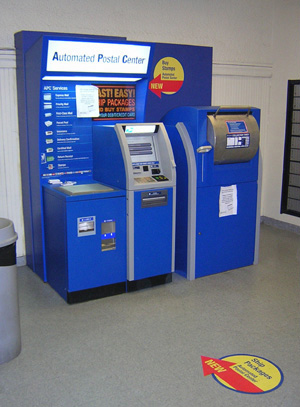Postal Service won’t let us ignore self-service

An Automated Postal Center stands unused in the Porter Square, Cambridge, post office Nov. 5, 2005. (Photo: Marc Levy)
The U.S. Postal Service’s self-service kiosks, despite being in town for more than a year, still seem to require constant attendance by a postal worker. This defeats the purpose, but, nonetheless, workers hover over the machines, instructing the occasional customer in their use while nearby lines languish — growing five deep, then six, then seven.
“Anybody want to use the machine?” one worker was heard asking in Porter Square. “It’ll save you a long wait in line.” Sometimes he amplified his sales pitch by noting that using the machine would save customers a “20- or 30-minute wait.”
Of course: He was one of two postal workers, and the other was behind the counter alone.
When asked why he waited by the Automated Postal Center when there was such a long line of customers, the worker explained that employees on site have “no control” over how they spend their day; a manager for the city, who works elsewhere, decides how employees are used. When asked whether he could get behind the counter and help the lone worker there, doubling the effective staffing of the station, if no one wanted to use the machine … well, no. Even when the worker at the counter had to leave to use the restroom, he was prevented from taking over her tasks.
And when asked if this was frustrating, he replied, “You got that right.”
After using the restroom, the worker ran back to her spot behind the counter. The line advanced one space.
From behind, the other worker could be heard making his pitch. When a customer responded, he could be heard assuring the man there was nothing to fear from using the machine.
“It’s pretty self-explanatory,” he said.
— — —
Bob Cannon, a public affairs manager with the U.S. Postal Service, says he hadn’t heard of policies preventing workers from returning to the counter when no one wants to use the machine. Under the circumstances, Cannon said, the worker should have.
The situation was unfortunate, he said, “first in that he wasn’t able to convince people they should have used that machine. Sometimes it takes people a while to get used to them.”
There are varying responses to the 19 machines scattered within Route 128, Cannon said, but most people “respond very well,” including unionized employees who may be hostile at first but find that “their worst fears don’t get realized and their work gets easier.”
There have been no jobs lost, he said, and there are no plans to fire or decrease hiring as the machines become more common. They’re just supposed to make things more convenient for customers who would otherwise have to wait for service. They’re also supposed to bring in more customers — stealing them away from competitors such as Federal Express and the United Parcel Service.
At the Fort Point, Boston, postal office, he said, people use the Automated Postal Centers enthusiastically. Why, he’s walked in to find people using the machines and completely ignoring the postal employees waiting behind the counters.
Right.
